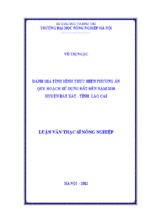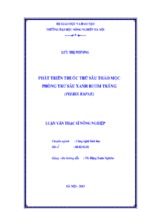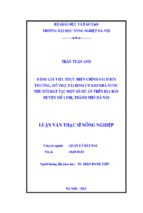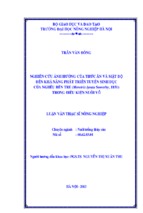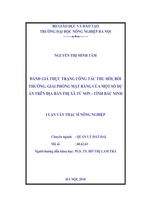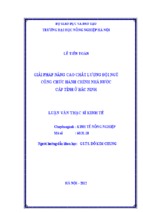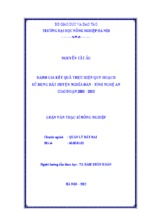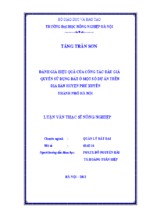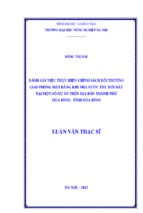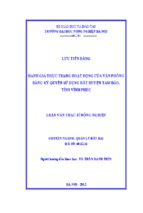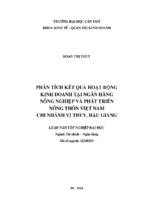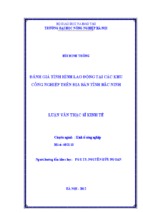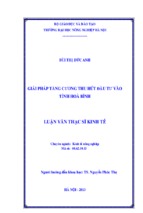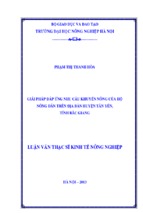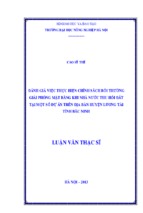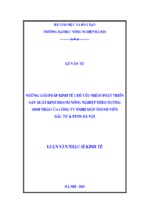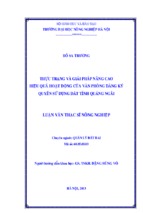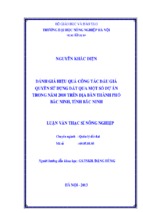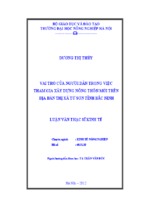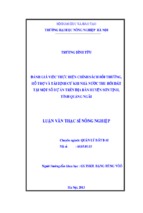VIETNAM NATIONAL UNIVERSITY OF AGRICULTURE
NGUYEN THI THANH XUAN
ASSESSMENT OF AFLATOXIN B1 CONTAMINATION
IN MAIZE AND AWARENESS OF AFLATOXINS
IN SON LA PROVINCE
Major
: Food Science and Technology
Code
: 60540103
Supervisor
: 1. Dr. Hu Suk Lee
2. Dr. Nguyen Thi Thanh Thuy
AGRICULTURAL UNIVERSITY PRESS - 2017
DECLARATION
This thesis contains no materials that have been accepted for the award of any
other degrees or diploma in any educational institutions. To the best of my knowledge,
my paper includes no previously published work written by any person, except where
indicated in references.
Hanoi, May 10th, 2017
Master candidate
Nguyen Thi Thanh Xuan
i
ACKNOWLEDGEMENTS
First of all, I am really grateful my supervisors Dr. Hu Suk Lee from International
Livestock Research Institute (ILRI) for his patience, enthusiasm, motivation and
immense knowledge, and to Dr. Nguyen Thi Thanh Thuy from Vietnam National
University of Agriculture, who gave me the opportunity to carry out this thesis and
always had a piece of advice ready regarding the practical aspect of my work. Their
guidance supported me during this research.
I wish to express my gratitude to Prof. Nguyen Viet Hung, a Southeast Asia
regional representative at ILRI in Vietnam, for giving me a profound insight into the
research and sharing his valuable experience with me. I always bear in mind the
enthusiasm Prof. Delia Grace and Dr. Johanna Lindahl at ILRI in Nairobi. I highly
appreciate Ms. Nguyen Le Thanh and Ms. Le My Hanh for their help in the
administrative aspect. Eventually, I would like to thank to all the members at ILRI in
Vietnam for giving me the opportunity to become temporarily a part of their team.
I owe my thanks to all staffs in Plant Protection Research Institute. They helped
me so much for conducting sampling, interview, data collection and laboratory analysis.
Many thanks particularly to the whole team, who went to Son La for their logistical
support and suggestion.
I also express my admiration to all members in Son La who introduced me to the
locals and supervised our team during sampling and interview process. I am also very
thankful to Son La residents who warmly welcomed our team in their homes and
participated in the survey.
Last but not least, I want to convey my gratefulness to my family and friends for
their unremitting support, patience and understanding.
Hanoi, May 10th, 2017
Master candidate
Nguyen Thi Thanh Xuan
ii
LIST OF CONTENTS
Declaration ......................................................................................................................... i
Acknowledgements ........................................................................................................... ii
List of contents................................................................................................................. iii
List of abbreviations ......................................................................................................... v
List of tables.................................................................................................................... vii
List of figures ................................................................................................................. viii
Thesis abstract.................................................................................................................. ix
Part 1. Introduction ........................................................................................................ 1
1.1.
Introduction ........................................................................................................ 1
1.2.
Research objectives............................................................................................ 2
Part 2. Literature review ............................................................................................... 3
2.1.
Situation in the maize production in vietnam – case of Son La ........................ 3
2.1.1.
Situation in the maize production in Vietnam .................................................... 3
2.1.2.
Study location - Son La province ....................................................................... 4
2.2.
Aflatoxins and their impacts on human and animal health ................................ 8
2.2.1.
Aflatoxins ........................................................................................................... 8
2.2.2.
The impact of aflatoxins on human and animal health ...................................... 9
2.3.
Factors influencing aspergillus spp. infection and aflatoxin development
in maize ............................................................................................................ 13
2.4.
Situation in the aflatoxin contamination in maize ........................................... 15
2.4.1.
Situation in the aflatoxin contamination in the world ..................................... 15
2.4.2.
Situation in the aflatoxin contamination in Vietnam ....................................... 16
2.5.
Methods to detect aflatoxins ............................................................................ 17
2.6.
Regulations for aflatoxins in the world and Vietnam ...................................... 18
2.6.1.
Regulations for aflatoxins in the world............................................................ 18
2.6.2.
Regulations for aflatoxins in Vietnam ............................................................. 21
Part 3. Materials and methods..................................................................................... 24
3.1.
Materials .......................................................................................................... 24
3.1.1.
Maize samples .................................................................................................. 24
3.1.2.
The Sigma-Aldrich® Aflatoxin B1 Low Matrix ELISA kit ................................ 24
3.2.
Methods ........................................................................................................... 24
iii
3.2.1.
Sample size calculation and selection ............................................................. 24
3.2.2.
Sampling .......................................................................................................... 25
3.2.3.
Aflatoxin B1 analysis in Lab............................................................................. 25
3.2.4.
Questionnaire survey ....................................................................................... 27
3.2.5.
Survey data analysis ........................................................................................ 27
Part 4. Results and discussions .................................................................................... 30
4.1.
Aflatoxin B1 contamination in maize in Son La .............................................. 30
4.2.
Awareness of aflatoxins in Son La .................................................................. 36
Part 5. Conclusions and recommendations ................................................................ 46
5.1.
Conclusions ...................................................................................................... 46
5.2.
Recommendations ............................................................................................ 46
References ....................................................................................................................... 47
Appendix ......................................................................................................................... 58
iv
LIST OF ABBREVIATIONS
Acronym
Abbreviations
A.
Aspergillus
A. flavus
Aspergillus flavus
A. nomius
Aspergillus nomius
A. parasiticus
Aspergillus paraciticus
AFB1
Aflatoxin B1
AFM1
Aflatoxin M1
AFs
Aflatoxins
CIT
Citrinin
DON
Deoxynivalenol
EC
European Commission
EFTA
European Free Trade Association
ELISA
Enzyme Linked Immunosorbent Assay
EU
European Union
F. moniliforme
Fusarium moniliforme
FAO
Food and Agriculture Organization of the United Nations
FB1
Fumonisin B1
FDA
Food and Drug Administration
FUM
Fumonisins
GAPs
Good agricultural practices
GPS
Global positioning system
HBV
Hepatitis B virus
HCC
Hepatocellular Carcinoma
HPLC
High-performance liquid chromatography
IARC
International Agency for Research on Cancer
LOD
Limit of detection
v
OD
Optical density
OTA
Ochratoxin A
PBS
Phosphate-buffered saline
PE
Polyethylene
ppb
Part per billion
TLC
Thin-layer chromatography
USA
United States of America
ZEA
Zearalenone
µg/kg
Microgram per kilogram
vi
LIST OF TABLES
Table 2.1.
Area under maize, maize production and yield of districts in Son La
in 2013 ......................................................................................................... 7
Table 2.2.
The property of aflatoxins............................................................................ 8
Table 2.3.
Limits of aflatoxin growth and production by A. flavus and A.
parasiticus .................................................................................................. 14
Table 2.4.
The FDA action levels for aflatoxins in human food and livestock
feed............................................................................................................. 20
Table 2.5.
Vietnamese limits for aflatoxins in human food ........................................ 22
Table 4.1.
Awareness of moldy contamination in maize in Son La ........................... 30
Table 4.2.
Prevalence of AFB1 contamination in maize in Son La ............................ 32
Table 4.3.
Awareness of molds among 107 respondents in each category
corresponding questions with answers ...................................................... 39
Table 4.5.
Practices associated with consumption of maize, meat and milk .............. 42
Table 4.6.
Practices related to the medical examination ............................................. 45
vii
LIST OF FIGURES
Figure 2.1. Agro-ecological regions in Vietnam .............................................................. 3
Figure 2.2. The administrative map in Son La province .................................................. 4
Figure 2.3. Area under maize, maize production and yield in Son La province .............. 6
Figure 2.4. Chemical structure of aflatoxins .................................................................... 9
Figure 3.1. The map shows sampling sites in Son La province ..................................... 25
Figure 4.1. Difference in the prevalence of AFB1 contamination in maize ................... 33
Figure 4.2. Socio- demographic characteristics of respondents ..................................... 37
viii
THESIS ABSTRACT
Master candidate: Nguyen Thi Thanh Xuan
Thesis title: Assessment of aflatoxin B1 contamination in maize and awareness of
aflatoxins in Son La province
Major:Food Technology
Code: 60540103
Educational organization: Vietnam National University of Agriculture (VNUA)
Research Objectives
This research was conducted to evaluate the prevalence of aflatoxin B1
contamination in maize and residents’ awareness of aflatoxins in Son La province.
Materials and Methods
Materials included maize samples and the Sigma-Aldrich® Aflatoxin B1 Low
Matrix ELISA kit.
Maize samples were randomly collected at the end of the rainy season from 25
communes in 5 districts in Son La with recording GPS location. All maize samples were
analysed for AFB1 contamination in Lab, using the Sigma-Aldrich® Aflatoxin B1 Low
Matrix ELISA kit. Besides, questionnaire survey was simultaneously carried out with
maize collection using face-to-face interviews. Eventually, all data were imported into
Microsoft Excel 2010 and analyzed using STATA (version 14.0, StataCorp, College
Station, TX, USA). ArcGIS version 10.4.1 ArcMap (ESRI, Redlands, CA, USA) was
used to create the map.
Main findings and conclusions
The prevalence of AFB1 contamination in maize in Son La was lower when
harvested in the field; however, this prevalence was higher in the rainy season.
Noticeably, most people had adequate awareness of molds and their impacts on human
and animal health, but they lack insight of aflatoxins and the impacts of aflatoxins,
particularly ethnic minority groups.
In conclusion, the findings can conclude that maize in Son La is exposed to AFB1
to varying degree, and there may be a risk that maize production could contain AFB1.
Therefore, we believe that this study produces evidence on potential risk to humans and
animals in Son La and will inform science-based messages for reducing risk.
Addtionally, the findings underline the need to enhance public's awareness about
aflatoxins and health risks associated with aflatoxins on human beings and animals.
ix
PART 1. INTRODUCTION
1.1. INTRODUCTION
Vietnam has an extremely advantageous geographical location in Southeast
Asia and Asia. It is located in both tropical and sub-tropical areas. Thus, its
climate features a tropical monsoon climate with high temperature and humidity
which is a favorable condition for fungal growth, especially mycotoxins
produced from Aspergillus spp. (CAST, 2003). Among mycotoxins, aflatoxins,
particularly aflatoxin B1 (AFB1) produced primarily by two species of
ubiquitous fungus Aspergillus (A.) including A. flavus and A. parasiticus have
attracted general public attention because it is the most toxic and potent
carcinogen even in small quantities (FAO, 1979 and De Campos, 1987).
According to The International Agency for Research on Cancer (IARC), AFB1 is
classified as group I carcinogens (Humans et al., 2002). Epidemiologically,
AFB1 can lead to be genotoxicity and carcinogenic toxicity for both human and
animal, especially the development of liver cancer (hepatocellular carcinoma)
and higher risk to hepatic B virus infected individuals (WHO, 1998; Hansen et
al., 2011 and Shephard, 2008). In fact, AFB1 is very susceptible in nuts and
cereal, especially maize and groundnut during the harvest, or gradually
susceptible while storing and processing (Reddy et al., 2009). Therefore, it is
extremely important to detect aflatoxins in food and animal feed for assurance of
human and animal health as well as food hygiene and safety.
In Vietnam, maize is the second only to rice as staple food for the
consumption of humans and animals, especially in the rural and mountainous
areas. It is regarded as the major energy feed source for Vietnam's livestock
industry (Ha et al., 2004). Mountainous North-west provinces, such as Son La,
are still listed as belong to the poorest in Vietnam with limited development
opportunities over the past years. Therefore, maize is also considered as one of
the most important crops. It grows in different ecological regions to alleviate
poverty in the provinces with difficult economic conditions. Nevertheless, maize
was reportedly extremely good substrate for fungal development producing
mycotoxins, especially aflatoxins (Wang and Liu, 2006 and Zinedine et al.,
2007). Meanwhile, Son La province is the largest maize producing area in
Vietnam but few comprehensive AFB1 investigations had been carried out to
1
establish the prevalence of AFB1 contamination in maize in Son La. Previously,
some studies on the occurrence of AFB1 in maize in Vietnam have provided
some insight; however, these were based on small sample sizes or limited-scale
geographical areas or relied on the data from one point in the maize value chain.
For instance, AFB1 was surveyed in 32 maize samples in a Wang et al.’s study
(1995), Trung et al. (2008) only conducted in 25 maize samples whereas a bigger
sample size (97 samples) were researched by Thieu et al. (2008) and Phuong et
al. (2015) (Wang et al., 1995; Trung et al., 2008; Thieu et al., 2008 and Phuong
et al., 2015). This would be difficult to generalize the population. Moreover, few
comprehensive AFB1 contamination research to establish the prevalence of AFB1
contamination in maize and unique study about perception and knowledge of
aflatoxins had been conducted in Son La (Lee et al., 2017). Therefore, an
investigation extended greater sampling was conducted to assess AFB1
contamination in maize and awareness of aflatoxins in Son La province.
1.2. RESEARCH OBJECTIVES
General objectives
This research conducted is to evaluate the prevalence of aflatoxin B1
contamination in maize and residents’ awareness of aflatoxins in Son La
province.
Specific objectives
-
To evaluate the prevalence of aflatoxin B1 in maize in Son La province in
an attempt to give recommendations to mitigate moldy contamination in maize.
- To evaluate the awareness of aflatoxins among people so as to improve
their understanding of health risks for both human beings and animals relating to
aflatoxins contamination by consuming maize in Son La.
2
PART 2. LITERATURE REVIEW
2.1. SITUATION IN THE MAIZE PRODUCTION IN VIETNAM – CASE
OF SON LA
2.1.1. Situation in the maize production in Vietnam
As in most of the Asian countries like China, Thailand, Indonesia, Vietnam,
maize production have been dramatically increasing during the last decade along
with the rapidly increasing demand for animal feed. The Vietnamese maize
production boosted from 1,177.2 thousand tons in 1995 to 2,005.9 thousand tons
in 2000 and drastically increased 5,281.0 thousand tons in 2015 (GSO, 2017).
This rapid increase leads to both
expansion in area and yield. Maize
production system was extended in
all the eight Vietnamese agroecological zones included North
West, North East, Red River Delta,
North Central Coast, South Central
Coast, Central Highlands, South East
and Mekong River Delta (Figure
2.1). In 2000, maize was grown on
730.2 thousand hectares and obtained
1,179.30 thousand hectares in 2015
(GSO, 2017). Maize developed in all
agro-ecological zones, especially in
Northern mountainous provinces.
The
recent
development
of
production particularly comes from
intensive areas of maize production
such as Son La, Dong Nai, Nghe An,
Thanh Hoa and so on, where maize
is grown on sloping and wet land as
well as invested in new seeds
dissemination (especially hybrid
seeds like LVN10, LV885, DK88
and so on).
Figure 2.1. Agro-ecological regions in
Vietnam
Source: Quyet (2013)
3
2.1.2. Study location - Son La province
Son La province is one of the largest maize producing areas in Vietnam
(GSO, 2017. It belongs to Northwestern agro-ecological zone. It is the fifth
largest province in Vietnam with the area of 14,174.4 km2 (GSO, 2017). It is
located in the northwestern region; it is bordered by Laos to the south, with Yen
Bai, Lao Cai, Lai Chau provinces to the north, Dien Bien province to the west
and Phu Tho and Hoa Binh provinces to the east (Figure 2.2). The provincial
capital is Son La city, which is located approximately 300 km from Hanoi. There
are 11 rural districts: Quynh Nhai, Muong La, Thuan Chau, Phu Yen, Bac Yen,
Mai Son, Song Ma, Yen Chau, Moc Chau, Sop Cop and Van Ho. Nearly 80% is
mountainous and its average elevation is 600 -700m above sea level.
Figure 2.2. The administrative map in Son La province
Source: GSO (2017)
4
The climate in Son La province is influenced by the tropical monsoon
climate, it is therefore charactered by both hot summer and cold winter with a
small amount of rain. Dry winter lasts from October to next March while rainy
summer lasts from April to September and shows its humidity and heat. Most of
the precipitation in years concentrates in June, July, August and September
(Appendix 2). The average annual temperature is 23°C (highest 35°C, lowest
11.5°C). The average rainfall in recent years ranges from 120 to 150 mm, and the
average humidity is 79% (GSO, 2017).
Son La province had a population of nearly 1,182.4 thousand people in
2005 with the density of 83 people/km2 (GSO, 2017). Similar to other Northwest
provinces, Son La’s population comprises many ethnic minorities: 54% are Thai,
13% are H'Mong, whereas Kinh or Viet (the major ethnic group nationwide)
accounts for only about 18% (Zohova, 2011). Other ethnics are Ma, Dao, Muong,
Khmer, Tay and Tai.
The province has a total land area of about 1.4 million hectares whereas
64% is agricultural land. Son La has a unique topography as it is partitioned
deeply by a high mountain range. Mountains and plateaus cover 75% of the
province (Karimov et al., 2016). Maize area and production in Son La have
increased significantly and now occupy a large part of the total maize production
area of the entire Vietnam, owing to its advantageous geography and climate.
Maize production in Son La increased mostly because of maize field expansion
and with a slight boost in maize yield. The province production satatistics based
on the area cropped and the corresponding quantity produce from 2004 to 2014
was shown in Figure 2.3 and Appendix 2.1.
5
Figure 2.3. Area under maize, maize production and yield in Son La
province
(2004 - 2014)
Source: GSO (2017)
Maize is planted in Son La in two main seasons. Maize is grown in swidden
fields in the summer season (it is planted in April or May and harvested in July
and August or maybe extended until September) while in the winter season maize
is cultivated in alluvial lands near rivers or stream banks. Furthermore, it has also
been grown in fields during the spring (Tran, 2005). Basically, there are two
kinds of maize that are cultivated. Local maize has been grown for years and
hybrid maize has been newly introduced as a part of the province’s overall
agricultural development strategy. Hybrid maize yields have higher productivity
than local ones but it is more vulnerable to the climate. Nevertheless, it is more
suitable to produce livestock feed. High domestic demand for maize leads to a
tremendous increase in maize imports. Therefore, it should be noted that there is
a high demand for maize in Son La because, according to the stakeholders at the
value chain assessment workshop, it is considered to be of better quality in
contrast to imported maize from China. It is one of the most important cash crops
for ethnic minorities and a big number of poor households in the uplands.
6
The maize grown area is not evenly distributed across Son La province,
partly due to inadequate agricultural land. The output is highest in Moc Chau,
Mai Son and Song Ma district, which also have the highest share of planted area
(Table 2.1). A majority of maize producers are small-scale farmers who depend
on maize sales for their livelihoods. In 2013, maize yields in the districts of Son
La ranged between 3 and 5 tonnes/ ha on average (Table 2.1). Farmers use
fertilizers to keep yields above average.
Table 2.1. Area under maize, maize production and yield of districts
in Son La in 2013
Area under maize
(thousand ha)
Maize production
(thousand tons)
Maize yields
(tons/ha)
Son La city
3.43
18.23
5.31
Quynh Nhai
4.35
13.35
3.07
Thuan Chau
8.73
33.1
3.79
Muong La
13.5
47.26
3.5
Bac Yen
11.89
42.83
3.6
Phu Yen
21.03
64.65
3.07
Moc Chau
22.75
97.21
4.27
Yen Son
17.87
77.81
4.35
Mai Son
21.16
99.15
4.69
Song Ma
23.88
101.12
4.24
Sop Cop
2.11
6.96
3.3
Van Ho
12.08
53
4.39
Districts
Source: Statistic Yearbook of Son La (2013)
Note: Van Ho district was recently separated from Moc Chau district.
Maize products particularly hybrid maize produced in Son La are mainly
supplied to enterprises in the livestock sector (for example CP Thailand joint
venture company). Moreover, Tran (2005) revealed that Son La maize was sold
in many markets such as Ha Tay, Thanh Hoa, Nam Dinh, Nghe An and so on.
That also means that maize in Son La became a highly market-oriented product.
7
2.2. AFLATOXINS AND THEIR IMPACTS ON HUMAN AND ANIMAL
HEALTH
2.2.1. Aflatoxins
Aflatoxins are toxic secondary metabolites produced by filamentous, which
can occur in host crops contaminated by some species of Aspergillus (Calvo et
al., 2002). Among Aspegillus spp., two strains such as A. flavus and A.
parasiticus can produce aflatoxins B1, B2, G1, G2, and M1 (Busby and Wogan,
1984). Worldwide, around 25% of agricultural products were contaminated with
aflatoxins (Wild and Gong, 2010 and Yard et al., 2013), while a number of
agricultural products are contaminated such as groundnut, maize, and cereal
grains with cereals, and groundnuts being the most susceptible (Wilson and
Payne, 1994).
Properties of aflatoxins
Hell (1997) stated that four major groups of aflatoxins are identified: B1,
B2, G1 and G2. These abbreviations are indicative of the colours these
fluorescence under the ultraviolet light (385 nm); thus B is for blue and G is for
yellow-green. The M is a hydroxylated metabolic product of B (Bankole and
Adebanjo, 2003).
Aflatoxins are crystalline substances. They not only dissolve freely in some
moderately polar solvents such as methanol, chloroform, dimethyl sulfoxide but
they also dissolve in water to the extent of 10-20 mg L-1. Several important
physical and chemical properties of aflatoxins are shown in Table 2.2 (Cole and
Cox, 1981).
Table 2.2. The property of aflatoxins
Property
Chemical Formular
Molecular weight
Melting point ( oC )
Sorbent, + Pentane
Flourescence
Aflatoxins
B1
B2
G1
G2
M1
C17H12O8
312
268-269
(D)
C17H14O8
314
287-289
(D)
C17H12O7
328
244-249
(D)
C17H14O7
330
C17H12O7
328
230
Ethyl
acetate
425 nm
299 (D)
Chloroform Chloroform Chloroform
425 nm
425 nm
450 nm
Methanol
425 nm
Source: Cole and Cox (1981)
D= Decomposition
8
Chemical structures of aflatoxins.
The chemical structures of some aflatoxins are shown in figure 2.4 (Cole
and Cox, 1981).
Figure 2.4. Chemical structure of aflatoxins
Aflatoxins are highly carcinogenic and can be acutely toxic or fatal if
ingested in sufficient quantities for both livestock and humans (Shephard, 2008).
2.2.2. The impact of aflatoxins on human and animal health
On human health
Aflatoxins are genetoxic, carcinogenic and immunosuppressive substances,
and cause both acute and chronic toxicity. Associated health problems are
difficult to diagnose, mainly due to cryptic, long-term and chronic exposures.
Nevertheless, in 2004 and 2005, the Kenyan government showed and recognized
that hundreds of human death cases were ascribed to the consumption of
aflatoxin contaminated maize products (Lewis et al., 2005).
Among worldwide countries, populations of developing countries are the
most susceptible to aflatoxicosis sickness. This is because security blankets of
developed countries in crops at pre-harvest and post-harvest level are quite
strict. The same occurs with milk derivates, because developing countries have
9
not accepted and assumed amenities as quick as developed countries. Shephard
(2003) and Williams et al. (2004) reported in developing countries worldwide
that there were more than 5 billion people at risk of chronic exposure to
aflatoxins through contaminated food. Because of being an alarming number,
aflatoxins have been recently considered as an important public health issue.
Adult humans usually have a high tolerance of aflatoxins, and, in the reported
acute poisonings, there are usually children who die (Cullen and Newberne,
1994).
The adverse impacts of aflatoxins in human beings and animals have been
categorized in two common forms:
Acute aflatoxicosis
It is produced when moderate to high levels of aflatoxins are consumed.
Specific, acute episodes of disease include hemorrhage, acute liver damage
which manifests as severe hepatotoxicity with a case fatality rate of
approximately 25%, edema, absorption and/or metabolism of nutrients and
alteration in digestion. The early symptoms of hepatotoxicity from aflatoxicosis
can include anorexia, malaise, and low-grade fever. Acute high-level exposure
can progress to potentially lethal hepatitis with vomiting, abdominal pain,
jaundice, fulminant hepatic failure and death (Walderhaug, 1992; Cullen and
Newberne, 1994 and Strosnider et al., 2006).
Chronic aflatoxicosis
It results from ingestion of low to moderate levels of aflatoxins. The effects
are usually subclinical and difficult to recognize. Some of the common
symptoms are impaired food conversion and slower rates of growth with or
without the production of an overt aflatoxin syndrome (Walderhaug, 1992).
Aflatoxicosis is not only caused by inhalation, but also, as mentioned
before, is caused by aflatoxin ingestion. In places like Brazil and Abu Dhabi,
there have been found lots of cases in which infants were exposed to aflatoxin M1
from mother’s breast milk. Aflatoxins have also been found in infant formula
(Aksit et al., 1997; Saad et al., 1995 and Navas et al., 2005). There are lots of
earlier studies reporting the presence of aflatoxins and derivatives in human
urine, blood, and human cord blood that apparently can enter the developing
fetus in humans and animals (Denning et al., 1990). The 80’s and 90’s were
10
- Xem thêm -


